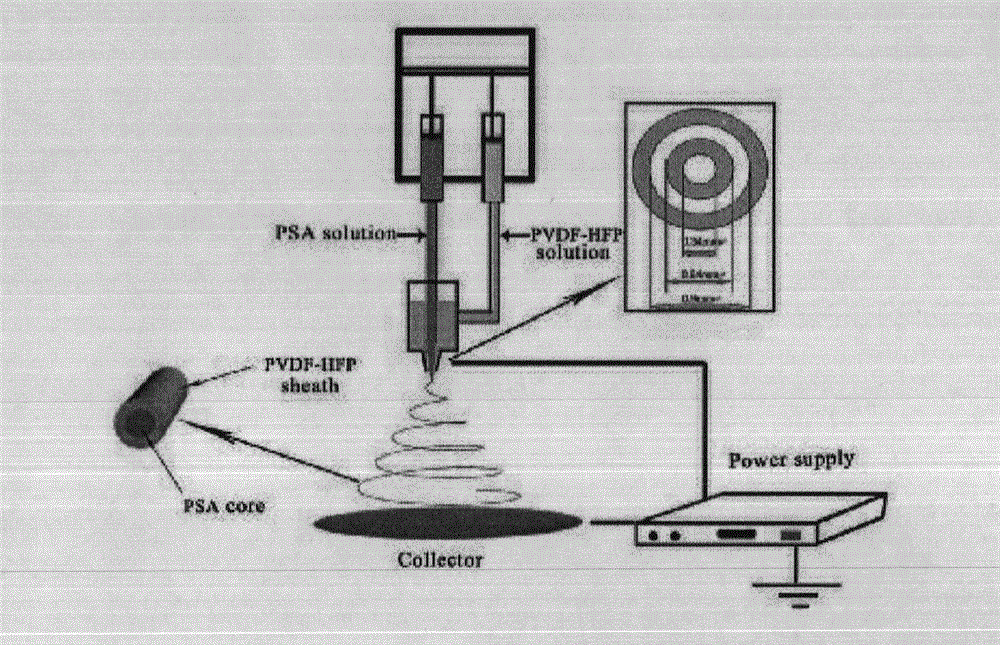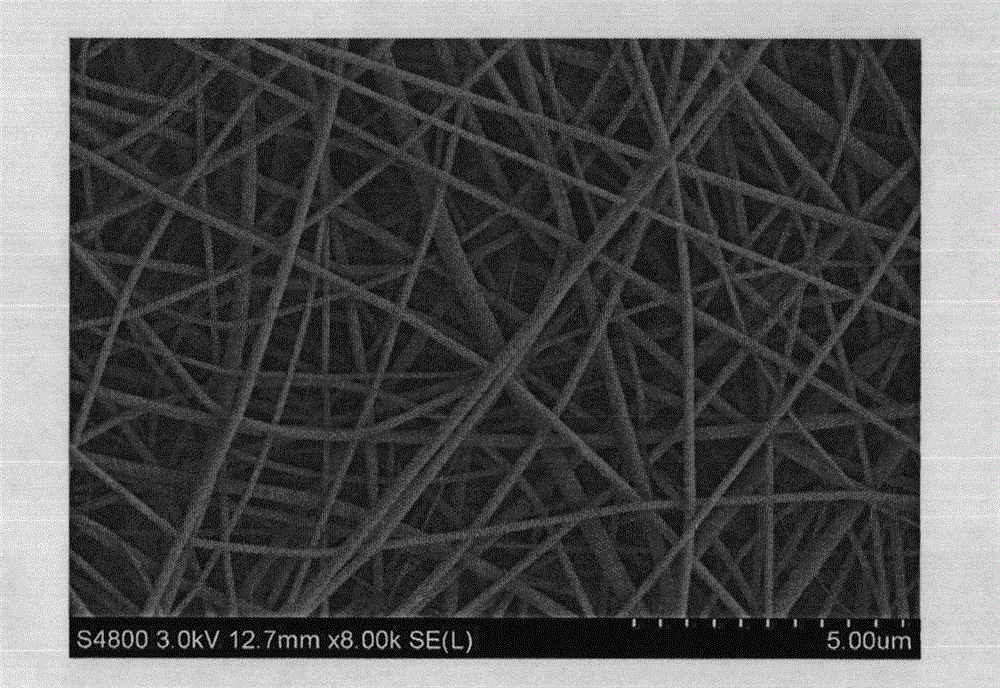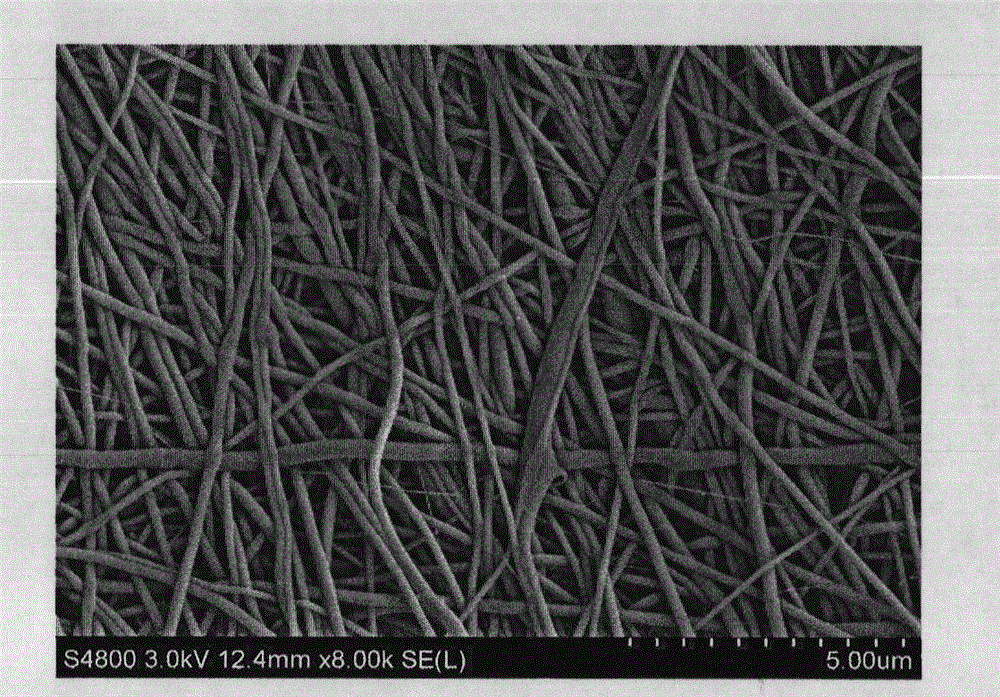A high-temperature-resistant polyarylsulfone amide-based lithium-ion battery separator
A polyarylsulfone amide-based, lithium-ion battery technology is applied in the preparation of the above-mentioned polyarylsulfone amide-based nanofiber membrane, and the application field of the above-mentioned polyarylsulfone amide-based nanofiber membrane in lithium ion batteries achieves pore structure distribution. Uniformity, excellent flame retardant performance and convenient preparation
- Summary
- Abstract
- Description
- Claims
- Application Information
AI Technical Summary
Problems solved by technology
Method used
Image
Examples
Embodiment 1
[0030] Add 30 g of N,N-dimethylacetamide and 4.88 g of polyarylsulfoneamide into a 100 ml reagent bottle, then stir at room temperature for 6 h to obtain a homogeneous solution of polyarylsulfoneamide (mass fraction: 14 % ). Another 1.0 ml polyarylsulfone amide solution was taken out for electrospinning, the needle diameter was 1.6 mm, the spinning voltage was 35 kV, the height from the needle tip to the receiving plate was 12 cm, and the electrospinning time was 3 h, the thickness of 60 μm was obtained. Polyarylsulfonamide nanofibrous membrane. Then the membrane was placed in a roller press with a pressure of 13 MPa for 2 min to obtain a polyarylsulfonamide nanofiber membrane with a thickness of 30 μm.
Embodiment 2
[0032] Add 4.88 g of polyarylsulfoneamide and 10 g of polyvinylidene fluoride-hexafluoropropylene into a 100 ml reagent bottle, then add 30 g of N,N-dimethylacetamide, and then stir at room temperature. The time was 6 h, and a homogeneous solution of polyarylsulfone amide (mass fraction 14 %) and polyvinylidene fluoride-hexafluoropropylene solution (mass fraction 25 %) was obtained. Another 2 ml of polyarylsulfone amide solution and 2 ml of polyvinylidene fluoride-hexafluoropropylene solution were taken out for coaxial electrospinning, the diameter of the needle was 0.34 mm, the flow rate of spinning solution was 0.08 ml / h, and the spinning voltage was 28 kV, the height from the needle tip to the receiving plate was 12 cm, and the electrospinning time was 5 h, a polyarylsulfoneamide@polyvinylidene fluoride-hexafluoropropylene nanofiber membrane with a thickness of 70 μm was obtained. Then the membrane was placed in a roller press with a pressure of 5 MPa for 2 min to obtain a ...
Embodiment 3
[0034]Add 30 g dimethyl sulfoxide, 5.3 g polyarylsulfone amide and 0.05 g nanometer silicon dioxide into a 100 ml reagent bottle, then stir at room temperature for 8 h to obtain a uniform polyarylsulfone amide / Nano silica solution (mass fraction is 27%). Another 2 ml of polyarylsulfonamide / nano-silica solution was taken out for electrospinning. The needle diameter was 1.6 mm, the spinning voltage was 20 kV, the height from the needle tip to the receiving plate was 12 cm, and the electrospinning time was 4 h. A polyarylsulfonamide / nano-silica nanofiber membrane with a thickness of 80 μm was obtained. Then the membrane was placed in a roller press with a pressure of 8 MPa for 2 minutes to obtain a polyarylsulfoneamide / nanometer silicon dioxide nanofiber membrane with a thickness of 50 μm.
PUM
| Property | Measurement | Unit |
|---|---|---|
| diameter | aaaaa | aaaaa |
| thickness | aaaaa | aaaaa |
| pore size | aaaaa | aaaaa |
Abstract
Description
Claims
Application Information
 Login to View More
Login to View More - R&D
- Intellectual Property
- Life Sciences
- Materials
- Tech Scout
- Unparalleled Data Quality
- Higher Quality Content
- 60% Fewer Hallucinations
Browse by: Latest US Patents, China's latest patents, Technical Efficacy Thesaurus, Application Domain, Technology Topic, Popular Technical Reports.
© 2025 PatSnap. All rights reserved.Legal|Privacy policy|Modern Slavery Act Transparency Statement|Sitemap|About US| Contact US: help@patsnap.com



